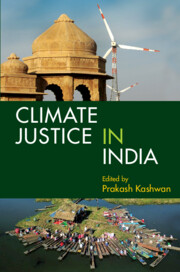Book contents
- Frontmatter
- Contents
- List of Poems and Artworks
- List of Tables
- List of Figures
- List of Abbreviations
- Preface and Acknowledgements
- 1 Introduction: Climate Justice in India
- 2 Urban Climate Justice in India
- 3 How Just and Democratic Is India’s Solar Energy Transition?: An Analysis of State Solar Policies in India
- 4 Extractive Regimes in the Coal Heartlands of India: Difficult Questions for a Just Energy Transition
- 5 Climate Justice Implications of the Relationship between Economic Inequality and Carbon Emissions in India
- 6 Climate Action Plans and Justice in India
- 7 Social Mobilizations for Climate Action and Climate Justice in India
- 8 Reimagining Climate Justice as Caste Justice
- 9 Intersectional Water Justice in India: At the Confluence of Gender, Caste, and Climate Change
- 10 Realizing Climate Justice through Agroecology and Women’s Collective Land Rights
- 11 Conclusion: Pathways to Policies and Praxis of Climate Justice in India
- About the Editor and Contributors
- About the Poets and Artists
- Index
5 - Climate Justice Implications of the Relationship between Economic Inequality and Carbon Emissions in India
Published online by Cambridge University Press: 03 November 2022
- Frontmatter
- Contents
- List of Poems and Artworks
- List of Tables
- List of Figures
- List of Abbreviations
- Preface and Acknowledgements
- 1 Introduction: Climate Justice in India
- 2 Urban Climate Justice in India
- 3 How Just and Democratic Is India’s Solar Energy Transition?: An Analysis of State Solar Policies in India
- 4 Extractive Regimes in the Coal Heartlands of India: Difficult Questions for a Just Energy Transition
- 5 Climate Justice Implications of the Relationship between Economic Inequality and Carbon Emissions in India
- 6 Climate Action Plans and Justice in India
- 7 Social Mobilizations for Climate Action and Climate Justice in India
- 8 Reimagining Climate Justice as Caste Justice
- 9 Intersectional Water Justice in India: At the Confluence of Gender, Caste, and Climate Change
- 10 Realizing Climate Justice through Agroecology and Women’s Collective Land Rights
- 11 Conclusion: Pathways to Policies and Praxis of Climate Justice in India
- About the Editor and Contributors
- About the Poets and Artists
- Index
Summary
Introduction
The carbon emissions of the world's richest 1 per cent are more than double the emissions of the poorest 50 per cent, despite the fact that climate change is expected to disproportionately affect the poor, especially in the warmer parts of the world (Oxfam 2020; Goswami 2020). This suggests that climate and socio-economic justice are intertwined, and understanding the nature of the relationship between carbon emissions and economic inequality can help us arrive at potential pathways to address both.
Climate and socio-economic justice are crucial in the case of India. India is a significant player in the global economy, as its gross domestic product (GDP) is the fifth largest in the world (World Bank 2021). However, the country also experiences staggering levels of economic inequality. It has the third highest number of billionaires, but it also has the largest poor population in the world (Ankel 2020; Roser and Ortiz-Ospina 2019). The wealth of the richest 1 per cent of the Indian population is more than four times the total wealth of the bottom 70 per cent (Economic Times 2020). These indicators of economic inequality demonstrate a dire need to enhance socio-economic justice in India.
Three different indicators of carbon emissions are widely used for analytical purposes. The present climate crisis resulted from historically accumulated greenhouse gas emissions, measured in carbon dioxide equivalents. The United States (US) is the largest contributor, accounting for about 25 per cent of the global cumulative carbon emissions between 1751 and 2019, while India contributed about 3 per cent (Ritchie 2019). Hence, India's historical cumulative carbon emission is rather low. The second indicator measures annual carbon emissions, or a country's current emission levels. Based on this indicator, India has the third highest carbon emission levels globally; it trails China and the US by a huge margin. The third indicator is per capita annual emissions, which accounts for differences in the population size of countries. When countries are ranked in descending order of their per capita carbon emissions, India ranked 128 out of 210 countries in 2019 (Crippa et al. 2020). Even though India's per capita carbon emissions and its share in cumulative global emissions is low, its current scale of emissions is a matter of concern (Matthews 2016).
- Type
- Chapter
- Information
- Climate Justice in India , pp. 98 - 114Publisher: Cambridge University PressPrint publication year: 2024
- Creative Commons
- This content is Open Access and distributed under the terms of the Creative Commons Attribution licence CC-BY-NC 4.0 https://creativecommons.org/cclicenses/
- 1
- Cited by



